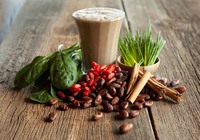Winter Dietary Adjustments
Posted by Derek Van Atta on 15th Mar 2020

Do you feel the same in the Winter as you do in the Summer? I know that my body and my psyche really benefit from making a handful of wise changes that one might call "Seasonal Shifts."
Depending on where you live, how you live, and your body type, many factors can go into your own personal "Seasonal Shift." Whatever climate you may be living in, it's important to know some ancient healing wisdom, especially when it comes to food. In this article, we'll go through a brief outline of this wisdom that can be found in traditions that span from Ayurveda to Taoism. The key is to stay balanced in your gut so that you can be vibrant all Winter long!
Stay grounded and fully nourished this Winter! You probably already feel yourself gravitating towards warmer, heavier foods simply because of the cold. Foods like soups, broths, and casseroles. The upside of this transition is that warming foods can be be grounding, nourishing, and balancing. The downside is that we may not be getting the important enzymes that are found in raw foods. But how do you continue to keep vital nutrition in your routine when fresh fruits and vegetables don't sound as tempting and may be more expensive, especially during the Winter?
Most of us are genuinely curious about what we can do to keep feeling our absolute best through the Winter. Nobody likes to get sick, and most of us are willing to do a few things to avoid colds and flu bugs if we can.
And some people don't get enough chlorophyll, or a nice broad spectrum of critical phyto-nutrients in the Winter. How can you be sure to get these micro-nutrients in the Winter and keep yourself from getting sick? The simplest answer: Eat veggies. Why? Because phyto-nutrients are only found in plants. So while animal protein can have its place, try not to make it your sole source of protein this Winter, and continue to eat as many brightly colored vegetables as much as possible.
Hot Food vs Cold Food
There are two ways for your food to warm you. One is with the actual temperature of the food. The other, lesser known technique, comes from the ancient healing traditions that classified all foods into three categories:
1. Cooling Foods.
2. Neutral Foods.
3. Warming Foods.
Cooling Foods
To give you a quick overview, all fruits are considered to have a cooling effect on your system, especially citrus fruits and melons. Fruits in general should be eaten in somewhat smaller quantities when you're trying to stay warm. The one exception to this rule is avocados. These are considered only mildly cooling and are the one fruit that is almost neutral. And here's a quick tip: Eating good quality salt on your avocado makes it fully neutral and not a cooling food.
What about proteins? Most animal proteins are warming foods. With a huge exception being milk, yogurt, and sour cream. These are all cooling foods in and of themselves, and because they must be kept refrigerated you end up with a bit of a double cooling effect. What about ice cream in winter? It's more like a triple cooling effect given that it contains sugar which is cooling, and it's also frozen!
Neutral Foods
The foods that are considered neutral are not a problem in Winter or Summer, and tend to be some of the lighter veggies like lettuce and celery.
What About Ayurveda? In the ancient tradition of Ayurveda, you'll find charts that list foods that are cooling and warming that will disagree with much of what you'll read here. This is partly due to the fact that Ayurveda is typically looking at what Dosha or Element is most likely to move out of balance. For instance, if you tend towards Pitta imbalance you would want to be more careful to avoid foods that are heating to your system. But this use of the word "heating" tends to be far too simplistic and too black and white. What is actually being pointed to is a tendency to be agitated, or stimulated, or aggravated in your nervous system and your glandular system by certain foods. But for this article, we're confining our discussion to a basic look at what helps us stay warmer in the Winter.
Warming Foods
Let's look at warming foods. In general all grains, seeds, beans, root vegetables, and all proteins are quite warming. The vegetables that grow above ground tend to range from neutral to slightly warming; Romaine Lettuce is neutral and Brussel Sprouts are slightly warming. In general, foods that contain "slow-burning" carbohydrates are going to be much more warming than foods that have significant sugar content.
There are also the warming spices. Don't underestimate the potency of spices just because the quantity you eat is smaller. For example, cinnamon is one of the most warming foods on earth! Ginger, black pepper, and red peppers are also good allies in terms of staying warm and happy during Winter.
Smoothies in Winter
Make smoothies "Winter-friendly!" I'm happy to say there are fantastic things you can do to make your smoothies way more warming and delicious when it's cold outside. First and foremost, skip the frozen fruit if that's part of your Summer Smoothie routine. Next up, run your blender longer than usual to actually warm up your smoothie to room temperature or higher. Lastly, add more nuts, seeds, and nutrient-dense foods to your drink!
Raw Food vs Cooked Food
When it's cold and you're not wanting to eat a lot of raw fruits and vegetables, it's much harder to get a healthy amount of enzymes in your daily diet. The other downside of eating less salads and fruits is that it becomes more difficult to get all of your micro-nutrients. Obtaining these key nutrients is essential for maintaining good health during the Winter months when it comes to your immune system and your overall mood. Sarvaa Superfoods are absolutely loaded with micro-nutrients to keep your vitality high and your happiness strong!
Quick and Easy Tips for Winter:
- Create a delicious warm beverage of your choice. And not just herb teas, but don't forget all the wonderful coffee substitutes. Or try a warm version of Cacao Plus! or Mayan Chocolate. Simply warm up almond milk, or coconut milk and stir in your favorite powder. Be careful not to overheat or boil so as not to destroy important enzymes!
- Experiment with dessert recipes with warming spices, especially cinnamon and ginger.
- Make stews, soups, and curries that are rich and creamy, and are full of yummy spices! A lot of ethnic foods tend to be warming, so liven up your kitchen experience and enjoy this Winter more thoroughly!
I hope a few of these tips are helpful to you! Live a vibrant life and continue to thrive!
~ Love Your Body ~ Love Everybody
